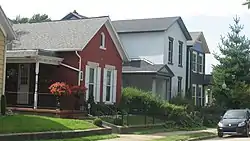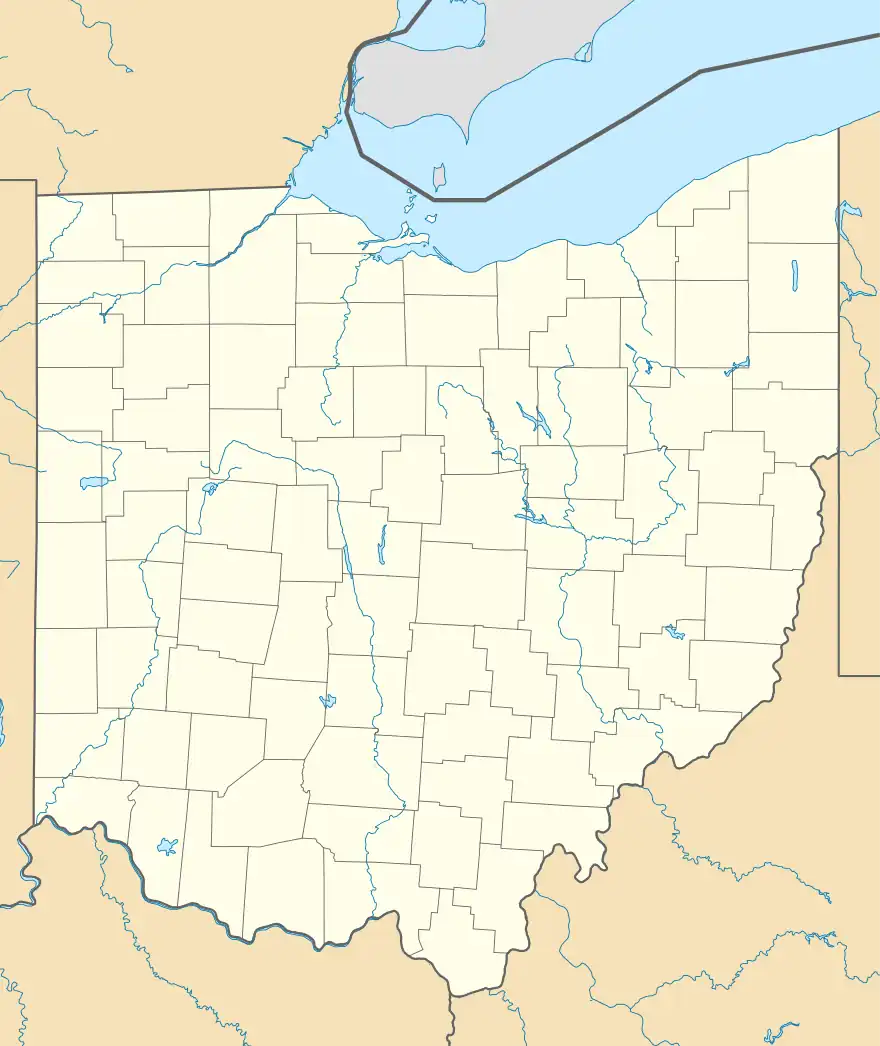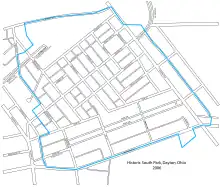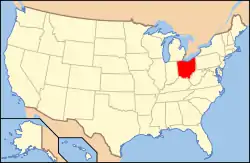South Park | |
 Houses on Perrine Street | |
  | |
| Coordinates | 39°44′54″N 84°10′44″W / 39.7483333°N 84.1788889°W |
|---|---|
| Built | 1880s |
| Architectural style | Second Empire, High Victorian Italianate, Queen Anne, Federal and Romanesque Revival |
| NRHP reference No. | 84003794[1] (original) 88000857 (increase) |
| Significant dates | |
| Added to NRHP | August 23, 1984 |
| Boundary increase | June 16, 1988 |
South Park is a 24-block, 150-acre area of more than 780 structures primarily dating from the 1880s to the early twentieth century. It is located south of downtown Dayton, Ohio, just north of the University of Dayton campus and Woodland Cemetery, and east of Miami Valley Hospital. Mainly residential in character, South Park is significant because of the variety of its architecture, which includes vernacular, cottage, and high style examples, and because of its association with John H. Patterson, founder of the National Cash Register Company (NCR).
Slidertown

The first structures were built in Sliderstown, named after Reverend Slider, in the mid-1800s.[2]
When John H. Patterson founded the National Cash Register Company in 1884,[3] the neighborhood around the factory complex, Slidertown, had a poor reputation.[4] To encourage workers to live closer in a beautiful environment, Patterson employed corporate welfare and began to clean up the area. He hired the Olmsted Brothers to design the landscape around the factory and recreate the neighborhood's cottage gardens as models for residents.[4][5] Residents also learned the principals of good planting so they had the skills to plant and maintain their own yards and prizes were awarded for the best gardens.[5] In 1897, the National Cash Register Company's Boys' Garden was founded to create a connection for boys in the neighborhood to learn responsibility that would ultimately make them successful citizens and workers and dissuade them from becoming a nusiance.[4][6]
In addition to the lanscaping, a kindergarden was established and the factory itself was the first "daylight factory" to complete the beautification of the workers environments.[5] By 1901, the area had become a garden-filled community and was known as the desireable neighborhood "South Park."[5]
Until the advent of the automobile enabled NCR workers to move further afield, the neighborhood continued to be associated with Patterson's firm, and many company picnics and other functions took place on Park Drive Boulevard in the heart of the district.[7]
Historic district

On August 23, 1984, South Park was registered on the National Register of Historic Places, bounding streets Park Dr., Morton Ave., Hickory St., and Wayne Ave. (No. 84003794). On July 16, 1988, this expanded to encompass Wyoming St., Nathan Pl., Oak St., Alberta St. and Blaine St. (No. 88000857).[8] City of Dayton Ordinance #26219.[9]
In 2007, South Park was chosen by the Dayton chapter of the American Institute of Architects as its community partner. This resulted in the creation of housing designs and landscaping concepts consistent with South Park's participation in Rehabarama in both 2001 and 2007.[10]
Architecture
Structures
The architecture of South Park includes examples of Second Empire, High Victorian Italianate, Queen Anne, Federal and Romanesque Revival in one- and two-story structures of brick and frame. South Park still preserves a sense of close-knit neighborhood whose residents cooperate to maintain the many neighborhood parks which give the district its special flavor.
Landscape
Commissioned by Patterson, John Charles Olmsted was responsible for the layout of Park Drive's landscape. This boulevard once adorned a fountain centerpiece and waterway running through its middle.[2]
Notable people
- Martin Sheen, actor[11]
See also
References
- ↑ "National Register Information System". National Register of Historic Places. National Park Service. July 9, 2010.
- 1 2 "From Slidertown to South Park, neighborhood has a long history". Dayton Daily News. October 11, 2007. Retrieved January 14, 2024.
- ↑ "History of NCR - Over a Century of Innovation". www.ncr.com. Retrieved January 14, 2024.
- 1 2 3 Lawson, Laura J. (2005). City Bountiful: A Century of Community Gardening in America. University of California Press. pp. 104–106. ISBN 0-520-24343-9.
- 1 2 3 4 Foster, Olive Hyde (1901). "Reforms Through Landscape Art". Fine Arts Journal. 12 (1): 36–38. ISSN 2151-2760.
- ↑ The Seed World. Issues Ink. 1920.
- ↑ "Dayton Daily News: Buck Pasture and Slidertown, A Part of Dayton".
- ↑ "OHIO - Montgomery County - Historic Districts". Retrieved August 28, 2006.
- ↑ "City of Dayton - Historic District Map" (PDF). Archived from the original (PDF) on October 12, 2013. Retrieved October 5, 2013.
- ↑ "Historic South Park". Retrieved May 21, 2007.
- ↑ "Arch interviews Martin Sheen: 'Activism is what I do to stay alive'". dayton-daily-news. Retrieved January 14, 2024.

